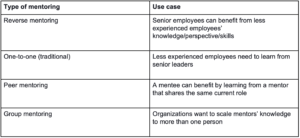In traditional hierarchical organizations, it’s senior employees who pass on wisdom and newer workers who learn from them. However, companies are increasingly recognizing that younger generations have perspectives and skills that can benefit their more experienced colleagues.
Many organizations are also struggling with generational gaps that make it harder to retain younger employees and relate to younger generations of customers.
Enter reverse mentoring, which helps companies capitalize on workers’ different generational strengths, while building intergenerational relationships that have lasting benefits for employees and organizations alike.
This article explores the benefits of reverse mentoring and the best practices that result in successful reverse mentoring programs.
What is Reverse Mentoring?
Reverse mentoring pairs workers inverts the usual mentoring relationship. Instead of the more senior worker mentoring the younger, the newbie supports the veteran. First popularized by Jack Welch, former CEO of GE, reverse mentoring at its core is the concept that everyone plays a valuable role in a company’s success.
The goal of reverse mentoring is to make the most of the unique knowledge and skill sets that people of different experience levels and generations bring to the table. Reverse mentoring emphasizes that learning never stops – no matter what age or seniority level – while supporting the idea that less experienced workers have something to teach.
What are the Benefits of Reverse Mentoring?
Reverse mentoring can strengthen the leadership pipeline, create a more inclusive culture and help employees advance in their careers. Here are some of the benefits:
Encourage professional relationships
Without reverse mentoring, a senior executive and entry-level hire might never have reason to interact. Once paired, these professionals have a chance to build a working relationship that can endure long after the immediate goals of the program are achieved.
Increase the exchange of knowledge, skills and experience
Reverse mentoring allows senior executives to stay up to date with the latest business technologies and workplace trends. It also helps junior employees see the larger organizational picture and gives them a glimpse of macro-level management issues.
Enhance diversity and inclusion
Research by McKinsey & Company shows that diversity, equity and inclusion (DEI) has a direct impact on profitability, workplace culture and innovation. Companies in the top quartile of gender diversity in leadership were 25% more likely to have above-average profits than their competitors in the bottom quartile. As well, companies in the top quartile for ethnic and cultural diversity outperformed the least diverse companies by 36%.
Reverse mentoring can play a vital role in encouraging DEI within organizations. For example, Proctor and Gamble used their “Mentoring Up” program to pair together senior leaders and employees with disabilities. This led to the discovery of internal videos that were not accessible to the hearing impaired. As a result, the videos were updated to add captioning.
Reverse mentoring programs focused on underrepresented employee groups build opportunities for these employees to interact with leadership, create pathways for advancement and break down cultural silos that might exist within a company.
Foster innovation and new perspectives
Innovation comes from thinking about something in a different way than has been done before. It’s harder to make these kinds of shifts when you’re always surrounded by people who have the same perspective and experience. Reverse mentoring offers the opportunity for people to be exposed to views and ideas outside their regular experience —and take inspiration from them.
Empower new hires
Reverse mentoring inverts the usual flow of knowledge by allowing less experienced workers to share insights with more senior colleagues. This empowers new hires and less senior staff by reminding both parties of their value to the organization. Within the safety of the mentoring relationship, younger or less experienced employees also have the opportunity to learn how to communicate with senior leadership.
Improve confidence and leadership skills in junior employees
Mentoring relationships are key to building a leadership pipeline. Reverse mentoring ensures that future leaders have an active opportunity to buy into the company. This type of program motivates them by valuing their work and ideas, while presenting an opportunity for leadership in driving the mentoring relationship.
Increase retention of top talent
Reverse mentoring has been shown to help retain both Millennials and older generations, as well as being a useful recruiting tool for Gen Z workers. Reverse mentoring offers the chance for workers to build strong relationships with one another, increasing their sense of belonging.
What are Best Practices for Reverse Mentoring?
It’s important to establish a strong foundation for your reverse mentoring program. Many of the best practices for any mentoring program apply to reverse mentoring as well. These include:
Creating a safe and trusting environment
Mentoring can’t be successful if people don’t feel that they can be themselves. Effective learning requires both teacher and student to be open, vulnerable and trust each other. Program managers should set this standard as part of participant preparation for reverse mentoring.
Encouraging open communication and active listening
Open communication is key to reverse mentoring, as well as active listening, which means participants are fully engaged with the other party. This includes:
- Listening attentively
- Understanding what the other party is saying
- Reflect on what the person said
- Responding appropriately
- Retaining the information for later
Additionally, having reverse mentoring topics on-hand helps to guide the conversation with a mentor and mentee.
Setting realistic and measurable goals
Before beginning reverse mentoring, participants need to define what they want to accomplish. The SMART framework offers a proven path to successful goal-setting. SMART means:
- Specific: Goals are clear and understandable
- Measurable: Success is well-defined, with quantifiable metrics
- Attainable: The objective is challenging, but not impossible
- Relevant: Goals need to be aligned to the needs of the organization and individual
- Time-bound: Deadlines and milestones are attached to specific dates
Regular evaluation and feedback
Both mentees and mentors need to know how they are doing and what they can do to improve. Evaluations should be scheduled at regular interviews and feedback should be thoughtful and constructive.
Want more best practices? Check out our article: 7 Reverse Mentoring Program Best Practices
What are the Drawbacks of Reverse Mentoring?
Reverse mentoring may not be the best approach for every situation. Drawbacks can arise when another approach would be a better fit, or when mentors and mentees aren’t a good match or when they don’t understand their roles or don’t feel comfortable fulfilling them.
How to overcome challenges in reverse mentoring
In most cases, reverse mentoring challenges can be overcome with clear expectations and communication.
For example, more senior team members may not believe that their younger mentors have valuable knowledge to share, and they may not be open to receiving feedback from people with less experience. Conversely, newer team members need to feel confident enough to share their opinions, and they may be less willing to participate if they are afraid of giving feedback to more established colleagues.
Before they even begin a reverse mentoring relationship, participants should receive information about common challenges, such as:
- Power dynamics
- Generational differences and communication styles
- Role reversals
- Hierarchical challenges
This will help mentors and mentees to identify areas of resistance and discuss with a shared vocabulary. It’s important for participants to be open about their challenges and be willing to work together with an open mindset so that they can create a harmonious, productive mentoring relationship.
When to choose reverse mentoring over other types of mentoring?
With any type of mentoring, the mentoring method needs to match the goals and needs of the organization and participants. Here’s a guide to different types of mentoring and when they may be warranted:
What are Examples of Reverse Mentoring?
Reverse mentoring has gained traction in leading companies in finance, tech, manufacturing, construction and consumer goods. A few examples:
Estee Lauder Companies
Founded by president and CEO Fabrizio Freda in 2015, Estee Lauder’s reverse mentoring program is structured as a cross-functional network pairing up senior leaders and rising talent. The company says that its program is helping senior leaders connect industry trends to business priorities, as well as supporting newer workers’ career development.
Lilly
Pharmaceutical company Lilly introduced a reverse mentoring program in 2020. The program matches (LGBTQ) employees and senior leaders with the goal of promoting inclusion and growth.
Labcorp
In Labcorp’s reverse mentoring program, younger employees with diverse backgrounds act as diversity mentors to executives. Since the program’s inception in 2020, 50% of diversity mentors have been promoted.
What are Future Trends of Reverse Mentoring?
Mentoring must change along with organizations and the greater business climate, and that’s true of reverse mentoring as well. Technological advances will continue to offer new tools and opportunities to expand the possibilities of reverse mentoring.
Tools that enable virtual mentoring will continue to make mentoring possible and productive across the globe, empowering mentors and mentees to connect in a meaningful way even if they are separated by time and distance. And artificial intelligence and machine learning will bring more intelligent automation to mentoring platforms to enhance exchange while reducing roadblocks and administrative hassles that can get in the way of successful mentoring.
Get Started with Reverse Mentoring Software
Reverse mentoring makes sure that employee knowledge and skills can be leveraged to benefit the organization — no matter how junior or senior those employees are. This type of mentoring can be a real boon to organizations looking to retain institutional knowledge and bridge generational gaps.
Running a reverse mentoring program doesn’t have to be complicated, but running one manually can become cumbersome and time consuming over time. As you seek to scale across your organization to different functions, locations and departments, reverse mentoring software can help you manage the growing number of participants and mentoring matches, all while keeping track of impact and efficiency.
Utilizing the Chronus mentoring platform can provide the following benefits:
- Set up optimized participant profiles to find the best match based on your program’s unique and specific criteria
- Train and guide participants through the relationship with built-in resources and materials
- Collect and analyze program feedback through surveys, reports and dashboards
- Minimize admin effort and time
With Chronus, reverse mentoring software enables your mentoring strategy to tackle your toughest talent challenges — without burdening your organization.


